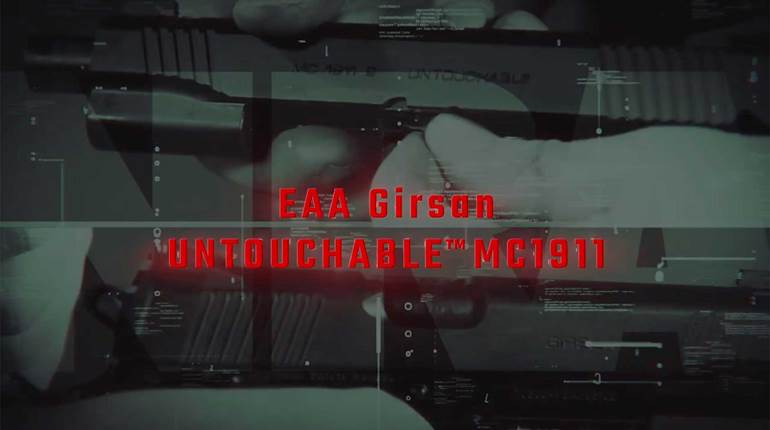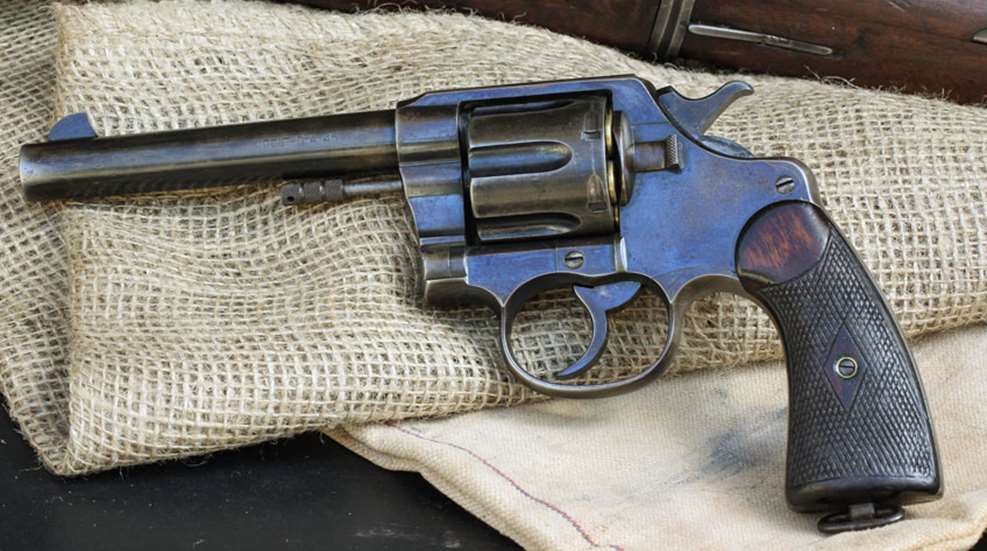
The Colt Model 1909 was the last military-issue .45 Colt. It would be nearly 100 years before another issue sidearm was specifically marked “USMC,” adding to the appeal of these unique .45s.
In 1909, the Ford Model T had just come to market. The President of the United States was none other than Theodore Roosevelt, finishing his second term. His Great White Fleet had finished its voyage around the globe, announcing to the world that America had arrived as a seapower. The Army Signal Corps had just purchased the world’s first military airplane from the Wright brothers. And Colt was in the process of delivering a new double-action revolver to the military. The .45 Colt-chambered Model 1909 was to replace various .38-cal. revolvers that repeatedly struggled to stop fanatical attackers in the then-ongoing Philippine Insurrection. The Army would receive approximately 20,000 1909s before the iconic U.S. Model of 1911 pistol was adopted. The Marine Corps specified a few changes to the gun for its order of 1,400.
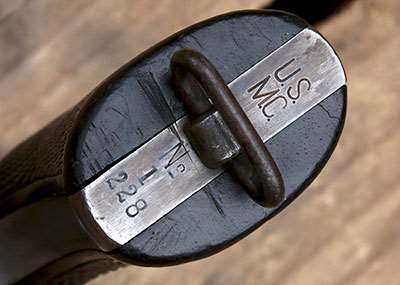
It is a well-established part of shooting lore that the U.S. military went back to the .45 Colt after dissatisfaction with the stopping power of its .38 revolvers in the early 1900s. More studied enthusiasts could probably tell you that the handgun was a double-action Colt revolver in .45 Colt. Beyond those details, things generally get fuzzy. That is understandable, as the M1909 Colt, although a superb heavy-duty handgun, was fielded in relatively small numbers and had the shortest service life of any issue sidearm in our nation’s history. The adoption of the iconic Colt M1911—and its storied service in conflicts arising shortly after its fielding—largely drown out the stopgap service of the M1909. The old M1909s aren’t commonly encountered and are quickly rising in cost to where the average shooter won’t get to experience them. So when the opportunity presented itself for this Marine to spend quality time with an M1909, and a scarce Marine Corps model, at that, I was understandably excited.
The M1909 is a brawny 39-oz. revolver. It is large, looking cartoonishly big in all but the largest of hands. The string of adjectives typically clumped together to describe the piece include robust, heavy-duty and serious. This is a not unexpected pendulum swing from the almost-dainty New Army series of issue .38 Long Colts that were known for lockwork that was anything but robust. Colt had clearly heard the complaints about the New Armys and responded with a handgun meant to easily take the most powerful loads of the era, and, with improvements to the action, intended to make it rugged and durable. They christened it the “New Service” upon its introduction, rather hopefully, and, eventually, the War Dept. came knocking as the complaints from the Philippines regarding the inadequacy of the .38s gained attention.
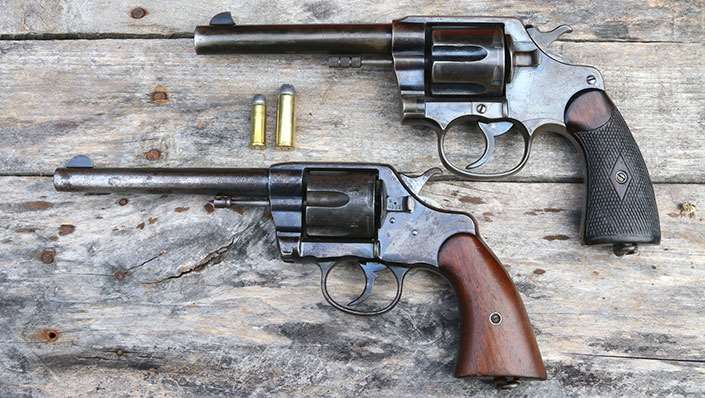
The .45 Colt was the powerhouse of the day with a track record dating back to its introduction in 1873. The old .45 loads intended for the Single Action Army had such a narrow rim that the extractor star of the M1909 could miss and bypass the cases, leading Frankford Arsenal to design a smokeless-powder load housed in a case with a slightly wider rim. Interestingly, the issue load for the M1909 was a reduced charge that pushed its 250-gr. bullet at only 725 f.p.s. The reasoning is lost to history, but it seems strange that the service load designed for a replacement handgun meant to increase stopping power was 100-150 f.p.s. slower than commercial loads of the time. I am guessing, but it may have been a combination of several factors. First, there was not yet a great deal of experience with smokeless loads in big-bore handguns, and the always conservative Ordnance Dept. might have wanted to err on the side of caution with the higher pressures produced by smokeless powder. Second, the recoil of full-charge .45 Colt is substantial, even in a large revolver. There is a significant and welcome difference between shooting that 250-gr. hunk of lead at 725 f.p.s. and a maximum load. Finally, one of the trends of the day was “heavy and slow” to maximize energy transfer into the target, with the thought being that loads that over-penetrated took energy unnecessarily out of the target and distributed it elsewhere. The British also espoused this theory with their service .455 Webley, which pushed a comparably heavier bullet even slower.
The Marine Corps of 1909 was tiny at a strength of only about 9,000 men. Whichever officer was in charge of handgun decisions must have either been a serious shooter with strong preferences or just hard to please. In 1905, the Corps had insisted that Colt round the butts and checker the stocks of its .38s rather than accept the basic Navy model. In 1909, the Marines made a similar request. The Marine Corps M1909 was the first “round butt” in the New Service line, and, unlike the plain walnut of the Army and Navy models, the Corps’ stocks had shallow checkering at about 13 lines per inch with a large diamond around the stock screw. The effect is a pronounced difference in the hand from the standard New Service frame. I prefer the Marine enhancements, and find that they put my hand in a better relationship with the trigger, especially in double-action.
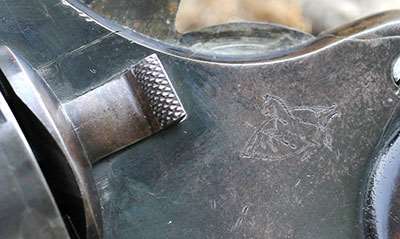
The M1909 shipped with Colt’s high-luster blue of that time frame that was truly blue in color and, 108 years on, is still remarkable. As beautiful a finish as it is, the blue was a poor match for service with soldiers of the sea. It is highly unusual to find one of the Navy or Marine Corps M1909s with very much of the bluing intact. The finish was neither wear- nor salt-resistant.
The action on the Marine gun is a fitting testament to a bygone era, and in the best possible way. The hammer looks somewhat like a scaled-down Single Action Army hammer, perhaps not surprisingly in an era where single-action was the predominant mode of fire. It falls easily under the thumb, and takes a bit more effort than modern designs but moves rearward with an oily smoothness and grace. The giant cylinder seems to move smartly of its own accord, visible more so than expected by a modern shooter as the recoil shield covers only a little over half of the cartridge rims. The trigger breaks with no perceptible movement—as in none. The shooter applies pressure and the hammer falls; there is no “wall,” no “roll” and no crisp “break.” There is a smoothness to the transaction that suggests a true master spent the time required with the sear and hammer under his tools until the parts release one another with no felt signal to the shooter. It is old-world magic, and the scale indicates that the break occurs at 5 lbs., 8 ozs., but it feels like three-something pounds of wonderful.
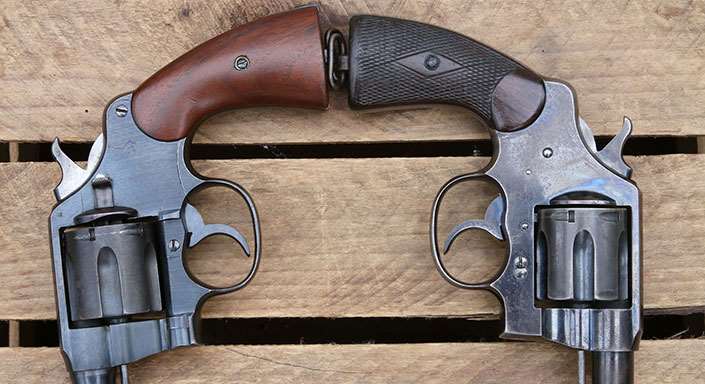
The double-action is smooth and buttery, albeit long. The New Service double-action arc is a tad heavy by design, and the trigger is positioned farther forward than most shooters can manage well. Still, the stroke on this particular M1909 is a horse length ahead of the M1917 Colts I’ve fired.
The sights on the Colt are actually quite good for the era, and are far better than what Colt was delivering on its Single Action Armys and semi-automatics at the time. The topstrap has a “U”-notch, and the shark-fin blade gives a more distinct front than the half-moons on the Smith & Wessons of the era. The Colt printed most loads about 5" above hold at 25 yds.
The M1909 served the Marines for only a short while, but it did accompany Smedley Butler and his men to Nicaragua for combat duty against the revolutionaries there. Not recorded to official history are the undoubted other occasions wherever the Marines roamed the seven seas and found the Colt to provide comfort in tense situations as the Great White Fleet spread American influence. The Marine Corps has a long tradition of squeezing the last drop of useful service out of items, and the tiny fraction of the 1,400 Marine revolvers still in circulation suggests this was the case. There are anecdotal reports of the Colts in armories in Haiti and elsewhere suggesting that wherever the Marines fought their “Small Wars,” the Colts were furnished to the gendarmeries and forces the Marines stood up and led.
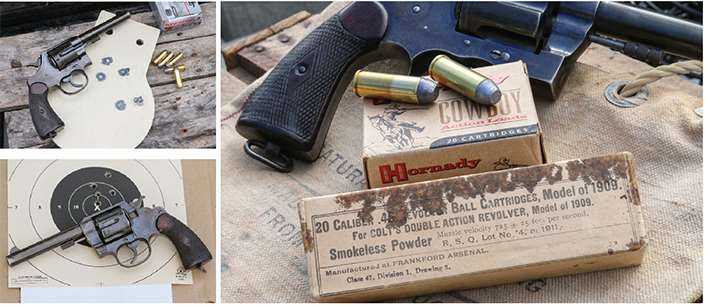
Getting to fire one of these rare Colts was a high privilege for this Marine. The M1909 is subtly different than the garden-variety M1917 or New Service. The extra smooth action and the round-butted frame of the Marine .45 gave it a boost, but it is at least possible that the provenance and “USMC” markings on the butt influenced my judgment.
The Colt consistently put five Black Hills .45s into 2¼" at 25 yds., and just as consistently put four of the five into a 1½" group. Casual shooting with the big double-action was enjoyable, and the hits came easily. The long-reach double-action took a little getting used to, and I suspect that those with small hands or little double-action experience would struggle, however, I was able to do good work with it.
After several positive shooting sessions, I had an idea. How would the Colt stack up on the current Marine Corps Pistol Qualification? The course of fire is a relatively recent change that incorporates pairs and failure drills from the holster from 7 to 15 yds. and deliberate shots at 25 yds., all within time limits on a silhouette target. Shots must fall within a roughly 6"x9"-sized chest area or the head box for max score. I scrounged a holster to fit the 1909 and gave it a go. I used Winchester cowboy loads, which are a dead ringer for the ballistics of the service load. The modest velocity helped recoil recovery in the rapid-fire strings at 7 yds. The Marine .45 came onto target naturally, and the hits tore a nice, tight, centered group with time to spare on each string. On one of the 25-yd. strings, I rushed the trigger a touch and pickled a shot just outside of the full credit line. The final tally was a remarkable 398 of 400 possible points. It would be hard to overstate how rewarding it was to shoot the old warrior and have it post such a score.
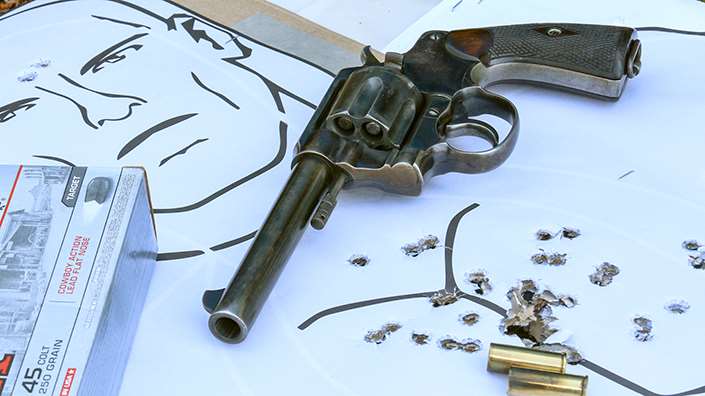
I try to shoot almost anything I get to handle against the 10-yd. steel plate rack. I find that the time to clear six 8" steel plates from the ready position is a good baseline practical comparison. My first few attempts with the M1909 were inauspiciously slow as I learned the long double-action arc. I took the rack on both single- and double-action and found that even learning the long stroke I was a good second-and-a-half faster when firing double-action. As I gained familiarity with the Colt and learned how to best grasp it and became acquainted with how the .45 pointed, speed came suddenly. With Hornady cowboy loads in the cylinder I was able to topple all six plates in as few as 3.71 seconds, which is a respectable time in the pocket of where I shoot modern big-bore revolvers. The shallow checkering seemed to make a considerable difference in anchoring the gun in hand at speed, and I was more than pleased.
Finally, I was finishing up on the range and happened to be 35 yds. away from an 8" steel hanger. Feeling froggy, I dropped rounds into the cylinder and thumbed the hammer back. Six shots later there were as many lead splatters on the steel in a 3½" group. That would be excellent for a high-end service pistol today but was especially rewarding for a worn 108-year-old veteran.
Simply put, this is an outstanding gun and must have been a formidable service sidearm. The M1909 exudes a Victorian charm and exotic call to adventure, and was undoubtedly a welcome companion to those Marines of long ago. I suspect some of the old salts were reluctant to trade it for the high-tech M1911s that replaced it so shortly after issue.












